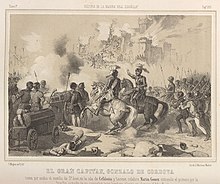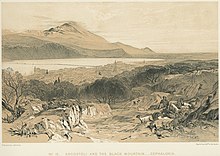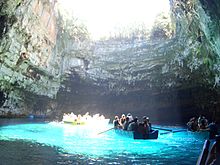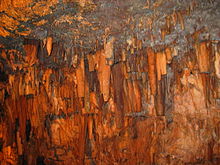Kefalonia
Cefalonia or Cefalenia (in Modern Greek Κεφαλονιά, trnsl.: Kefalonia, trnsc.: Kefaloñá; in ancient Greek Κεφαλληνία, trnsl.: Kefallēnía; trnsc.: Kefalenía) is an island in the archipelago of the Ionian Islands or Heptaneso, belonging to Greece. It was the center of the former Kefalonia prefecture, which had an area of 904 km² and about 35,000 inhabitants. On January 1, 2011, with the new administrative division of Greece, it was divided into two peripheral units: Kefalonia and Ithaca. It is located south of Lefkada.
History
Homer mentions her under the name Same or Samos. Her name would derive from Cephalus who became master of the island with the help of Host. Herodotus is the first to give this name to the island (Kefalonia). The island consisted of four states (tetrapolis): Same, Pale, Cranios and Pronos. These names would derive, according to legend, from the four sons of Cephalus. Same and Pronos (today Tafio and probably earlier Tafos or Tafus) were on the east coast, Cranios and Pale to the west. The ruins of a Roman city are also preserved in Cabo Escala, to the southeast, probably built in the 1st century and called Cephalenia. Today it is close to the castle of San Jorge and is next to the plain of Livadhó. To the north are also the remains of a fortress called Asso, which may be ancient Nesus.
In the Medic Wars, only Pale sided with Athens and sent two hundred soldiers to fight in the Plataea. The island joined the Delian League at the beginning of the Peloponnesian War.
Cefalonia was an ally of Athens, being annexed by it in 431 B.C. C. and being later devastated by the Romans in 189 a. C. In the time of the geographer Claudius Ptolemy it was included in the province of Epirus.
During the wars with the Romans the cities of the island opposed Rome. Aetolia dominated the island and Rome sent Marco Fulvio Nobilior with an army in 189 BC. C. Three cities submitted, but Same held out and was conquered after a four-month siege. The Romans recognized the island as a free city.
The island was under Byzantine rule until the end of the 11th century, when it was taken by the Norman Roberto Guiscard in the year 1085. He died there that same year after suppressing the revolt on the island, when he besieged one of the cities, and gave the port its name: Fiscardo. With his death it returned to Byzantium, but it was later occupied by the Norman pirate Margaritone of Brindisi in 1185 and in 1194 it was returned to the Byzantines, but actually kept by Count Mateo I Orsini (Margaritone's grandson) and by Count Leon Vetrano. Vetrano was executed by the Venetians in 1206 and Orsini seized all power.
Shortly after the capture of Constantinople in 1204 by the Crusaders, it passed to the Franks and was included within the principality of Achaia. The fief was entrusted to Gaius, Prince of Taranto who accepted the protection of Venice in 1215; in 1224 Venice recognized the Orsini who had not lost control. After the Orsini family, it passed to Naples in 1324. In 1357, the Prince of Taranto returned it to Venice and it was integrated into the lordship of Zante, governed by the Tocco, a Neapolitan family. When the last count, Carlos Tocco, died, power passed to his son and his wife Francesca.
It belonged to Turkey for only twenty-one years (1479-1500), when it was controlled by the Venetians until 1797. In 1479 it was conquered by the Turks. The Venetians reconquered the island in 1482, but returned it to Turkey by a treaty in 1485, although they maintained the fief through a tribute. The Turks established a garrison in the castle of Saint George. At the end of 1500, a Spanish-Venetian assault force (9,000 Spaniards, 2,000 Venetians and 600 French) under the command of Gonzalo Fernández de Córdoba (the Great Captain) recovered the island after a fierce siege of the aforementioned citadel. It remained since then in the power of Venice, with its capital in San Jorge until this castle was destroyed by an earthquake in 1757 and the capital was moved to the port of Argostoli.
In 1797, the Republic of Venice was abolished and the French acquired its possessions. On June 28, 1797 the French occupation took place. The islanders welcomed the French as liberators and raised the French flag. On October 17, 1797, it formally passed to France through the Treaty of Campoformio. On November 7, 1797, the French created the departments of Corfu, Ithaca (which included Ithaca, Lefkada, Kefalonia, Préveza and Vonitsa) and the Aegean Sea (Zante and others). It remained under French rule until the Russians and Turks occupied the island on November 9, 1798 (they had already occupied Corfu before). On April 2, 1800, the Republic of the Seven Islands was created, under a Russian and Ottoman protectorate. This situation lasted until July 20, 1807, when Russia ceded Kefalonia and the other islands to France and renounced the protectorate. On September 13, 1807, Kefalonia was annexed to France and on October 8, 1809, it became part of the Illyric Provinces. In October 1809, the British occupied the island and kept it occupied until 1814, when it was decided to establish the Republic of the Ionian Islands under a British protectorate on behalf of the powers that was proclaimed on November 5, 1815. Seventeen British governors governed the island between 1814 and 1863, of whom special mention should be made of Sir Charles Napier (March 12, 1822 to 1830) and to a lesser extent Sir C. S. Everton (late 1840s). At that time, about 60,000 people lived on the island.
In 1863, the islands were handed over to Greece by the London Protocol (Corfu, Cephalonia, Zante, Lefkada, Ithaca, Cythera, Paxos and other minor ones). On June 1, 1864, the incorporation into Greece took place after formalizing the Treaty of London.
Ioannis Metaxas was born on the island, a dictator who established a fascist regime in Greece between 1936 and 1941. Precisely that same year, during the Second World War, the Italians occupied the island, remaining there until 1943. After the liberation of southern Italy in 1943, Italian troops were disarmed by German troops and shot or imprisoned in concentration camps. In 1945, after the German defeat, the island was left in the hands of the British forces who returned it to Greece. In 1953, it was devastated by an earthquake and part of the 365 villas that were there disappeared. Fiscardo, the port, was almost intact.
List of Counts of Kefalonia
- Margaritone de Brindisi 1185-1194 (Sicily award)
- Ricardo Orsini, regent 1194-h. 1203 (Byzantine award)
- Matthew I Orsini 1194/1203-1238 (Byzantine fief, Venetian fiefdom since 1224)
- Gaius de Tarento 1205-1224 (nominal) (date of the Latin Empire and of Acaya 1205-1215, of Venice 1215-1224)
- Regulation (probably Ana Angela) 1238-1260
- Ricardo I Orsini 1238/1260-7 April 1304 (son of Matthew)
- John I Orsini 7 April 1304-1317 (after John I Angel-Comne) (son)
- Nicolás I Orsini 1317-1323 (son)
- John II Orsini 1323-1324 and 1325-1335 (brother)
- a Naples 1324-1357
- Niceforo II Orsini 1335-1358 (son)
- Leonardo I Tocco 1358-1381
- Carlo I Tocco 1381-1429 (under the sovereignty of Venice since 1386) (son)
- Leonardo II Tocco (brother) associated in 1414
- Carlo II Tocco 1429-1448 (son of Leonardo II and adopted son of Carlos I)
- Raimondina Ventimiglia, regent 1448-1460
- Leonardo III Tocco 1460-1479
- Francesca Marzano de Aragona 1479-1480 (de facto)
- Turkish occupation 1480-1482
- Leonardo III Tocco 1482-1500 (death in 1503) (Turkey's recipient, absent)
- Francesca Marzano de Aragona 1482-1500 (de facto)
- Carlo III Tocco, vacuum 1503
- Leonardo IV Tocco, vacuum cleaner 1518
Venetian Governors
- 1700-1702 Marcantonio Contarini
- 1702-1704 Angelo Falier
- 1704-1706 Domenico Pizzamano
- 1706-1708 Angelo Malipiero
- 1708-1710 Fantino Dandolo
- 1710-1712 Benetto Minotto
- 1712-1714 Luigi Marcello
- 1714-1717 Paolo Minotto
- 1717 Gianvincenzo Donato
- 1717-1719 Gianfrancesco Giustiniani
- 1719-1721 Lodivico Diedo
- 1721-1723 Daniele Balbi
- 1723-1725 Antonio Boldu
- 1725-1727 Pietro Pasqualigo
- 1727-1729 Gabriele Boldu
- 1729-1731 Benetto Civrano
- 1731-1733 Dolfin Gaetano
- 1733-1735 Girolamo Bolini
- 1735-1738 Jacopo Pasqualigo
- 1738-1740 Nicolò Boldú
- 1740-1742 Nicolò Pizzamano
- 1742-1744 Pietro Antelmi
- 1744-1746 Giambattista Baseggio
- 1746-1748 Pietro Morosini
- 1748-1750 Andrea Minotto
- 1750-1752 Pasquale Cicogna
- 1752-1755 Nicolò Cornaro
- 1755-1757 Agostino Soranzo
- 1757-1759 Alberto Magno
- 1759-1761 Pietro Contarini (first time)
- 1761-1763 Girolamo Marcello
- 1763-1765 Angelo Longo
- 1765-1767 Vido Marcello
- 1767-1769 Giovanni Oizzamano
- 1769-1772 Giampaolo Trevisano
- 1772-1774 Pietro Contarini (second time)
- 1774-1776 Giovanni Bernardo
- 1776-1778 Antonio Pasta
- 1778-1780 Marcantonio-Francesco Semitecolo
- 1780-1782 Andrea Dolfin
- 1782-1785 Angelo Venier
- 1785-1787 Domenico Muazzo
- 1787-1789 Angelo Orio
- 1798-1791 Angelo-Maria Giorgio
- 1791-1793 Bartolommeo Cicogna
- 1793-1795 Carlantonio Marin
- 1795-July 1797 Jacopo Marin
British Governors (1809-15)
- October 1809 - 1810 Lord Hudson Lowe
- 1810 - 1814 Charles James Napier
Territorial division
Since 2019, what until then was the municipality of Kefalonia was divided into three municipalities:
- Argostoli
- Lixouri
- Sami
Contenido relacionado
Villabishop of Otero
Zurich
Serbia and Montenegro








